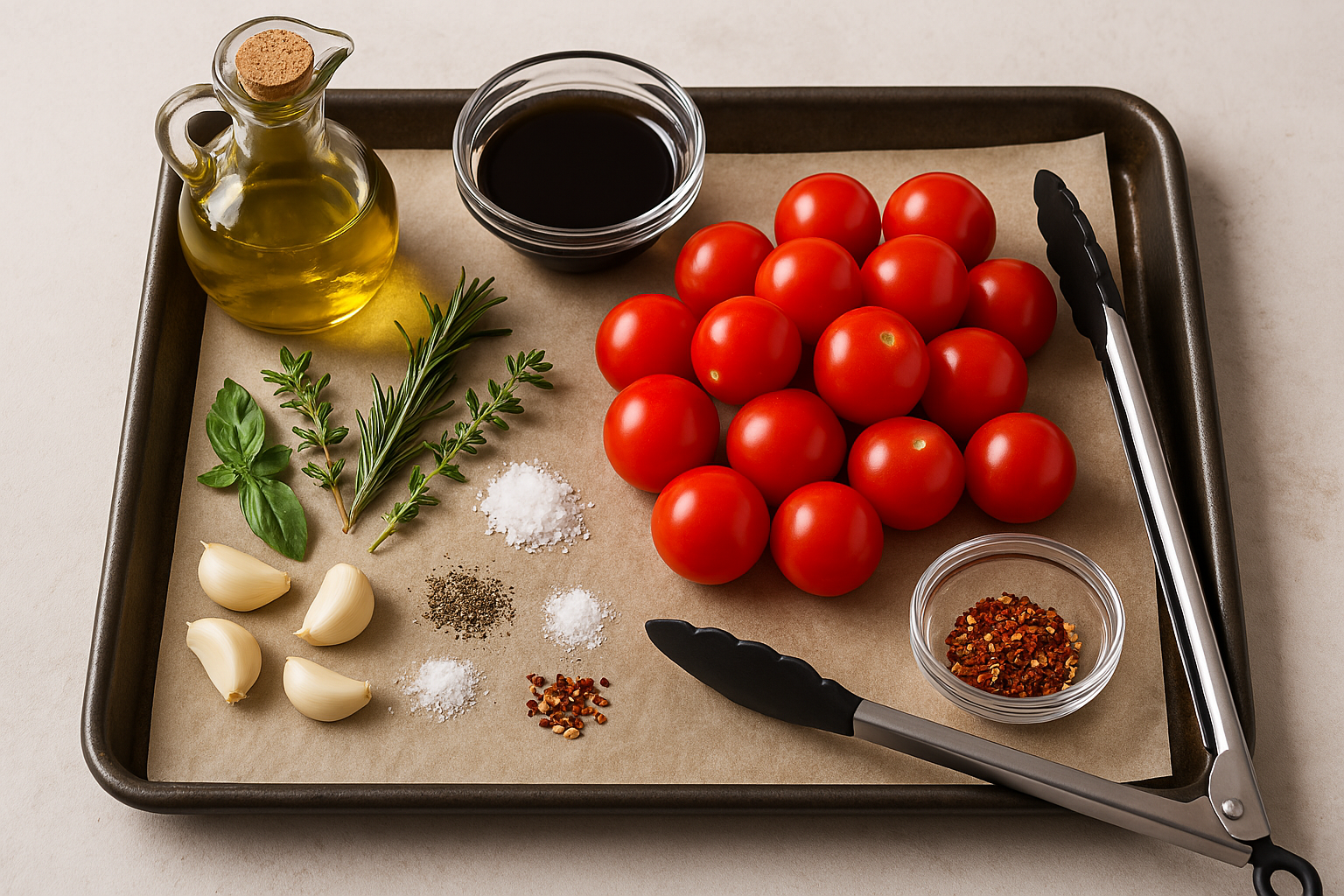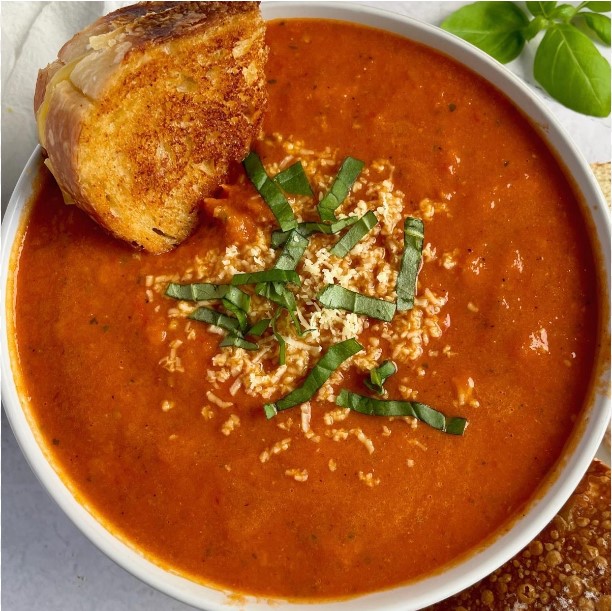Tomato soup is a timeless comfort—velvety, tangy, and soul-warming. But if you’ve only ever made it with boiled or canned tomatoes, you’re missing out on a transformative step: roasting.
Roasting tomatoes before blending them into soup unlocks a depth of flavor that’s smoky, sweet, and irresistibly rich. In this article, we’ll explore the ideal roasting temperature, techniques, tomato varieties, and how to build a soup that sings with layered complexity.
Why Roast Tomatoes?
Table of Contents

Roasting tomatoes caramelizes their natural sugars, concentrates their flavor, and adds a subtle smokiness that boiling simply can’t achieve. It also reduces excess moisture, giving your soup a thicker, silkier texture.
Benefits of Roasting Tomatoes
• Intensifies sweetness and umami
• Adds complexity through browning (Maillard reaction)
• Enhances aroma and color
• Reduces acidity for a smoother finish
The Ideal Roasting Temperature For Roasting Tomatoes
The sweet spot for roasting tomatoes is 400°F (200°C).
This temperature strikes the perfect balance:
• Hot enough to caramelize sugars and blister skins
• Gentle enough to avoid burning or drying out the flesh
You can go slightly higher (425°F/220°C) for a darker roast or slightly lower (375°F/190°C) for a slower, juicier roast—but 400°F is the gold standard for soup-making. Follow this guide for roasting cherry tomatoes.
Choosing the Right Tomatoes For Roasting

Not all tomatoes are created equal. For soup, you want varieties that are meaty, flavorful, and low in water content.
Best varieties for roasting are:
- Roma (Plum) – They are known for their dense, mildly sweet flavour.
They are also Ideal for roasting because of their low moisture.
- San Marzano – They are rich, balanced and acidic in flavour. San Marzano are premium choice for soups.
- Campari – Campari tomatoes are Juicy and sweet. You can roast them whole or halved.
- Heirloom tomatoes- They are complex, earthy. These tomatoes are great for rustic-style soups.
- Cherry/Grape Tomatoes – These tomatoes are intensely sweet. You can roast whole for bursts of flavor. Avoid overly watery varieties like beefsteak unless you’re roasting them longer, or straining the soup.
Flavor Boosters to Roast Alongside

Roasting tomatoes alone is delicious—but pairing them with aromatic companions elevates the entire dish.
Add to the roasting tray:
• Garlic cloves (whole or smashed): mellow, nutty flavor
• Onion wedges: caramelized sweetness
• Red bell peppers: smoky depth
• Fresh herbs (thyme, rosemary): infuse oils and aroma
• Chili peppers (optional): for heat and complexity
Drizzle everything with olive oil, sprinkle with salt and pepper, and roast until edges are charred and tomatoes collapse.
Step-by-Step Roasting Guide to Roast Tomatoes For Soups

Here’s a detailed method to roast tomatoes for soups:
Ingredients:
• 2 lbs ripe Roma or San Marzano tomatoes, halved
• 1 large onion, quartered
• 6 garlic cloves, peeled
• 1 red bell pepper, seeded and sliced
• 2 tbsp olive oil
• Salt and pepper to taste
• Optional: fresh thyme or rosemary sprigs
Instructions:
1. Preheat oven to 400°F (200°C).
2. Arrange tomatoes cut-side up on a baking sheet lined with parchment.
3. Scatter onion, garlic, and bell pepper around the tomatoes.
4. Drizzle with olive oil and season generously.
5. Add herbs if using.
6. Roast for 35–45 minutes, until tomatoes are blistered and edges are caramelized.
7. Remove from oven and let cool slightly before blending.
Building the Soup Base

Once your tomatoes are roasted, it’s time to build the soup. You can go rustic or refined depending on your mood.
Basic Roasted Tomato Soup:
1. Transfer roasted ingredients to a blender or food processor.
2. Add 2 cups vegetable or chicken broth.
3. Blend until smooth (or leave slightly chunky for texture).
4. Pour into a pot and simmer for 10–15 minutes.
5. Adjust seasoning: salt, pepper, a pinch of sugar if needed.
6. Finish with a splash of cream, coconut milk, or a drizzle of olive oil.
Optional Add-ins:
• Fresh basil or parsley
• A spoonful of pesto
• Roasted carrots or squash for sweetness
• Parmesan rind during simmering
• Croutons or grilled cheese for serving
Balancing Flavors
Roasted tomato soup should be bold but balanced. Here are a few tips:
• Too acidic? Add a pinch of sugar or a splash of cream.
• Too thick? Thin with broth or water.
• Too bland? Try a dash of balsamic vinegar, smoked paprika, or Worcestershire sauce.
Taste as you go—roasting gives you a strong foundation, but seasoning brings it to life.
Styling and Serving Tips

Since you love food photography and plating, here are some visual ideas:
• Serve in rustic ceramic bowls with a swirl of cream and fresh basil.
• Garnish with roasted cherry tomatoes on skewers.
• Pair with grilled cheese cut into bite-sized cubes for dipping.
• Use a drizzle of herb oil or chili oil for contrast.
Natural light, a textured linen napkin, and a wooden board can make your soup shots pop.
Seasonal Variations
Tomato soup isn’t just for summer. Try these seasonal twists:
• Autumn: Add roasted squash or carrots, garnish with sage.
• Winter: Use canned San Marzano tomatoes, add smoked paprika and cream.
• Spring: Stir in fresh peas or asparagus tips, finish with lemon zest.
Final Thoughts
Roasting tomatoes for soup is more than a technique—it’s a philosophy. It’s about coaxing out flavor, honoring the ingredient, and creating something that feels both rustic and refined. Whether you’re cooking for comfort or crafting a dish to photograph and share, roasted tomato soup is a canvas for creativity.
So next time you’re staring at a pile of ripe tomatoes, save some to roast them properly for soups.
Leave a Reply